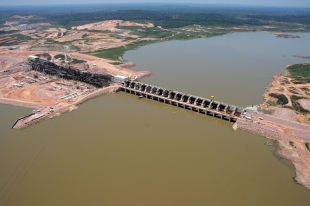“Green Bond” Issue Risks Raising Finance for Destructive Dams
When a group of banks came together in January to launch the Green Bond Principles, our immediate concern was that the group’s reluctance to adopt guidelines to detail what can be considered “green” risked setting a poor precedent that others could easily exploit.
It looks like such fears are closer to being realized. GDF Suez’s recent green bond issue, the largest green bond so far by a corporation, has potentially raised money for a controversial large dam in the Amazon, the Jirau Dam in Brazil.
It appeared that GDF Suez' bond issue would support environmentally sustainable projects. In a directive, GDF stated that in order to be eligible for bond support, projects must comply with social and environmental criteria in five areas, such as environmental protection, contribution to local development, and the well-being of local communities. Additionally, the ESG ratings agency Vigeo confirmed that the bond’s project pipeline met their sustainable development standards. Indeed, Crédit Agricole and Citi, the banks which acted as Structuring Advisor and coordinator of the bond issue, are two of the Green Bond Principles’ four founding partners.
However, the Jirau Dam has proven to be far from a “sustainable” investment. The project and its downstream counterpart, the Santo Antônio Dam, are two of four controversial dams planned as a cascade on the Madeira River, the largest tributary to the Amazon. Both dams are taller than 15 meters, and as such are considered “large dams” by the World Commission on Dams and the International Commission on Large Dams (ICOLD). Although neither dam is designed for traditional reservoir storage, and are thus technically considered “run of the river,” both dams inundate areas beyond the banks of the river. When such dams are built in a cascade on a water body as wide as the Madeira, they typically create greater, cumulative impacts that are difficult to mitigate, in comparison to smaller dams on lesser tributaries.

The Jirau Dam, soon to be completed, has already caused serious impacts on freshwater ecology, local communities and workers. For example, scientists have pointed out several valuable migratory fish species that could suffer near-extinction as a result of the dam. Sedimentation and water quality are of great concern as the dams trap nutrients and vegetation in the riverbed where they may accumulate and decay, turning the river toxic. The areas inundated by both the Jirau Dam and Santo Antônio Dam have exacerbated damages caused by recent historic floods in the region, forcing thousands of people to be displaced from their property. Meanwhile, the consultation of affected communities and indigenous people was highly insufficient, Brazil’s federal indigenous agency FUNAI confirmed that nearby un-contacted indigenous populations have suffered impacts, and workers previously set fire to installations on at least two occasions, in protest over poor working conditions and sub-par pay.
Much of the bond’s €2.5 billion (US$3.4 billion) price tag is meant to finance projects with greater social, environmental, and climate benefits than the Jirau Dam. Indeed, socially responsible investors who noted such potential apparently purchased 64% of the issue. Still, how many investors have scrutinized GDF Suez' pipeline in sufficient detail as to filter out the harmful projects that such a bond might support? The company is openly contemplating other potentially destructive hydro projects in the Peruvian and Brazilian Amazon, particularly on the Tapajós River. The Jirau Dam may be only one of a number of bad projects that receive finance from this “green” bond.
It is notable that the previous record-holder for the largest corporate green bond issue, Electricité de France (EDF), another large French player in the renewable energy market, has avoided scrutiny over the green credentials of its bond issue by unambiguously restricting the use of the proceeds for investments in wind and solar projects, excluding large dams altogether.
Until issuers agree to adhere to strong criteria on what can and cannot be considered “green,” a “green bond” such as this issue from GDF Suez may still be a disastrous investment for both people and planet.
An earlier version of this post was originally published in Environmental Finance under the title “Is GDF’s Green Bond issue really green?“.
- Read BankTrack's "Dodgy Deals" page on the Jirau and Santo Antônio Dams on the Madeira River


